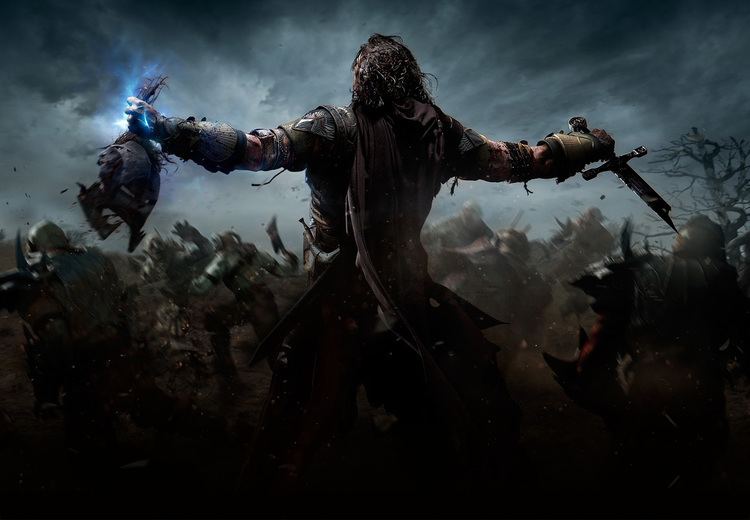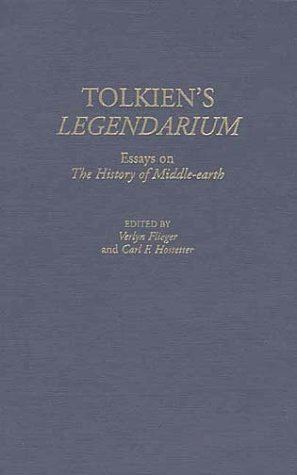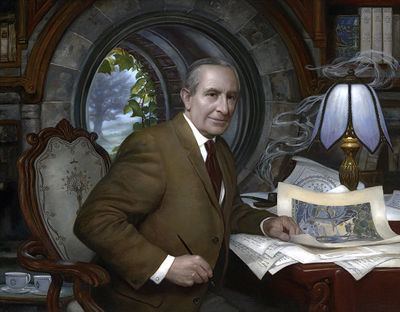 | ||
Tolkien's legendarium is the term for the entirety of J. R. R. Tolkien's mythopoetic writing that forms the background to his The Lord of the Rings. Tolkien worked and re-worked the components of his legendarium throughout his adult life, or during a period of more than 50 years; the earliest drafts, published in The Book of Lost Tales (1983) dating to 1916.
Contents
- The consequences of dwarven greed in tolkien s legendarium
- Origin of the term legendarium
- Tolkiens use of the term legendarium
- Use of the phrase Tolkiens legendarium
- History of development
- Works cited
- References

Colloquially, "Middle-earth" is popularly used as a shorthand for a "canonical" or mature form of Tolkien's narrative, Middle-earth being Tolkien's term for the inhabited part of the world in which most of his published stories were set.

The mythological and cosmological background of Tolkien's published works was sketched in the posthumously-published The Silmarillion (1977), and in Tolkien studies as a field as it has developed since the 1980s.

The consequences of dwarven greed in tolkien s legendarium
Origin of the term legendarium

The term legendarium refers to a literary collection of legends. This obscure medieval Latin noun originally referred mainly to texts detailing legends of the lives of saints. A surviving example is the Anjou Legendarium, dating from the 14th century. Quotations in the Oxford English Dictionary for the synonymous noun legendary date from 1513. The Middle English South English Legendary is an example of this form of the noun.
Tolkien's use of the term legendarium

Tolkien used the term legendarium with reference to his works in a total of four letters he wrote between 1951 and 1955, a period in which he was attempting to have his unfinished Silmarillion published alongside the more complete The Lord of the Rings:
Use of the phrase Tolkien's legendarium
"Tolkien's legendarium" is defined in the analytical work The History of the Hobbit by John D. Rateliff, as the body of Tolkien's work consisting of:
All of which comprise the different "phases" of Tolkien's Elven legendary writings, posthumously edited and published in The Silmarillion and in their original forms in the series The History of Middle-earth.
While other Tolkien scholars have not seen fit to define their use of the term, it is used in the following contexts:
History of development
Unlike "fictional universes" constructed for the purpose of writing and publishing popular fiction, Tolkien's legendarium for a long period was a private project, concerned with questions of philology, cosmology, theology and mythology. It has been considered a "pure mythopoeia".
Tolkien first began working on the stories that would become The Silmarillion in 1914, intending them to become an English mythology that would explain the origins of English history and culture. Much of this early work was written while Tolkien, then a British officer returned from France during World War I, was in hospital and on sick leave. He completed the first story, "The Fall of Gondolin", in late 1916.
He called his collection of nascent stories The Book of Lost Tales. This became the name for the first two volumes of The History of Middle-earth, which include these early texts. The stories employ the narrative device of a mariner named Eriol (in later versions, an Anglo-Saxon named Ælfwine) who finds the island of Tol Eressëa, where the Elves live; and the Elves tell him their history. However, Tolkien never completed The Book of Lost Tales; he left it to compose the poems "The Lay of Leithian" and "The Lay of the Children of Húrin".
The first complete version of The Silmarillion was the "Sketch of the Mythology" written in 1926 (later published in Volume IV of The History of Middle-earth). The "Sketch" was a 28-page synopsis written to explain the background of the story of Túrin to R. W. Reynolds, a friend to whom Tolkien had sent several of the stories. From the "Sketch" Tolkien developed a fuller narrative version of The Silmarillion called Quenta Noldorinwa (also included in Volume IV). The Quenta Noldorinwa was the last version of The Silmarillion that Tolkien completed.
When Tolkien did publish The Hobbit in 1937 (which was itself not originally intended for publication but as a story told privately to his children), the narrative of the published text was loosely influenced by the context of the legendarium, but not designed to be part of it.
In 1937, encouraged by the success of The Hobbit, Tolkien submitted to his publisher George Allen & Unwin an incomplete but more fully developed version of The Silmarillion called Quenta Silmarillion, but they rejected the work as being obscure and "too Celtic". The publisher instead asked Tolkien to write a sequel to The Hobbit. Tolkien began to revise The Silmarillion, but soon turned to the sequel, which became The Lord of the Rings. Writing The Lord of the Rings during the 1940s, Tolkien was attempting to address the dilemma of creating a narrative consistent with a "sequel" of the published The Hobbit and a desire to present a more comprehensive view of its background. He renewed work on The Silmarillion after completing The Lord of the Rings, and he greatly desired to publish the two works together (The Lord of the Rings remained unpublished for close to a decade following its completion). When it became clear that would not be possible, Tolkien turned his full attention to preparing The Lord of the Rings for publication.
With the success of The Lord of the Rings, Tolkien in the late 1950s returned to The Silmarillion, planning to revise the material of his legendarium into a form "fit for publication", a task which kept him occupied until his death in 1973. Much of his later writing from this period was concerned more with the theological and philosophical underpinnings of the work than with the narratives themselves. By this time, he had doubts about fundamental aspects of the work that went back to the earliest versions of the stories, and it seems that he felt the need to resolve these problems before he could produce the "final" version of The Silmarillion. During this time he wrote extensively on such topics as the nature of evil in Arda, the origin of Orcs, the customs of the Elves, the nature and means of Elvish rebirth, and the "flat" world and the story of the Sun and Moon. In any event, with one or two exceptions, he wrought little change to the narratives during the remaining years of his life.
